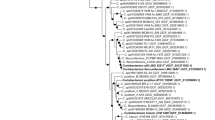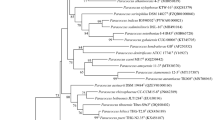Abstract
A Gram-stain negative, coccoid- or oval-shaped and non-gliding bacterial strain, designated CDM-17T, was isolated from the zone where the ocean and a freshwater spring meet at Jeju island, South Korea, and subjected to a polyphasic taxonomic study. Strain CDM-17T was observed to form smooth, circular, glistening, slightly convex, light yellowish pink colonies on marine agar, and was found to grow optimally at pH 7.0–8.0, at 30 °C and in the presence of 2–3 % (w/v) NaCl. A neighbour-joining phylogenetic tree based on 16S rRNA gene sequences showed that strain CDM-17T fell within the clade comprising the Roseivivax species, clustering with the type strain of Roseivivax sediminis with which it exhibited 98.3 % sequence similarity value. Sequence similarities to the type strains of the other recognized Roseivivax species were 94.7–96.8 %. Strain CDM-17T was found to contain Q-10 as the predominant ubiquinone and summed feature 8 (C18:1 ω6c and/or C18:1 ω7c) as the major fatty acid. The major polar lipids were identified as phosphatidylcholine, phosphatidylglycerol, an unidentified aminolipid, an unidentified glycolipid and an unidentified lipid. The DNA G+C content of strain CDM-17T was determined to be 66.2 mol% and its mean DNA–DNA relatedness value with Rsv. sediminis KCTC 23444T was 17.5 ± 2.7 %. Differential phenotypic properties, together with the phylogenetic and genetic distinctiveness, revealed that strain CDM-17T is distinguishable from recognized Roseivivax species. On the basis of the data presented, strain CDM-17T is proposed to represent a novel species of the genus Roseivivax, for which the name Roseivivax jejudonensis sp. nov. is proposed. The type strain is CDM-17T (=KCTC 42110T = CECT 8625T).


Similar content being viewed by others
References
Barrow GI, Feltham RKA (1993) Cowan and Steel’s manual for the identification of medical bacteria, 3rd edn. Cambridge University Press, Cambridge
Bowman JP (2000) Description of Cellulophaga algicola sp. nov., isolated from the surfaces of Antarctic algae, and reclassification of Cytophaga uliginosa (ZoBell and Upham 1944) Reichenbach 1989 as Cellulophaga uliginosa comb. nov. Int J Syst Evol Microbiol 50:1861–1868
Bruns A, Rohde M, Berthe-Corti L (2001) Muricauda ruestringensis gen. nov., sp. nov., a facultatively anaerobic, appendaged bacterium from German North Sea intertidal sediment. Int J Syst Evol Microbiol 51:1997–2006
Chen MH, Sheu SY, Chen CA, Wang JT, Chen WM (2012) Roseivivax isoporae sp. nov., isolated from a reef-building coral, and emended description of the genus Roseivivax. Int J Syst Evol Microbiol 62:1259–1264
Cho JC, Giovannoni SJ (2006) Pelagibaca bermudensis gen. nov., sp. nov., a novel marine bacterium within the Roseobacter clade in the order Rhodobacterales. Int J Syst Evol Microbiol 56:855–859
Dai X, Shi X, Gao X, Liu J, Zhang XH (2014) Roseivivax marinus sp. nov., isolated from deep water. Int J Syst Evol Microbiol 64:2540–2544
Ezaki T, Hashimoto Y, Yabuuchi E (1989) Fluorometric deoxyribonucleic acid–deoxyribonucleic acid hybridization in microdilution wells as an alternative to membrane filter hybridization in which radioisotopes are used to determine genetic relatedness among bacterial strains. Int J Syst Bacteriol 39:224–229
Felsenstein J (1981) Evolutionary trees from DNA sequences: a maximum likelihood approach. J Mol Evol 17:368–376
Felsenstein J (1993) PHYLIP (phylogeny inference package) version 3.5. Distributed by the author. Department of Genome Sciences, University of Washington, Seattle
Jukes TH, Cantor CR (1969) Evolution of protein molecules. In: Munro HN (ed) Mammalian protein metabolism, vol 3. Academic Press, New York, pp 21–132
Kim OS, Cho YJ, Lee K, Yoon SH, Kim M, Na H, Park SC, Jeon YS, Lee JH, Yi H, Won S, Chun J (2012) Introducing EzTaxon-e: a prokaryotic 16S rRNA Gene sequence database with phylotypes that represent uncultured species. Int J Syst Evol Microbiol 62:716–721
Kluge AG, Farris JS (1969) Quantitative phyletics and the evolution of anurans. Syst Zool 18:1–32
Komagata K, Suzuki KI (1987) Lipid and cell wall analysis in bacterial systematics. Methods Microbiol 19:161–207
Lányí B (1987) Classical and rapid identification methods for medically important bacteria. Methods Microbiol 19:1–67
Leifson E (1963) Determination of carbohydrate metabolism of marine bacteria. J Bacteriol 85:1183–1184
Minnikin DE, Patel PV, Alshamaony L, Goodfellow M (1977) Polar lipid composition in the classification of Nocardia and related bacteria. Int J Syst Bacteriol 27:104–117
Minnikin DE, O’Donnell AG, Goodfellow M, Alderson G, Athalye M, Schaal A, Parlett JH (1984) An integrated procedure for the extraction of bacterial isoprenoid quinones and polar lipids. J Microbiol Methods 2:233–241
Park S, Kang SJ, Oh TK, Yoon JH (2010) Roseivivax lentus sp. nov., isolated from a tidal flat sediment, and emended description of the genus Roseivivax Suzuki et al., 1999. Int J Syst Evol Microbiol 60:1113–1117
Reichenbach H (1992) The order Cytophagales. In: Balows A, Trüper HG, Dworkin M, Harder W, Schleifer KH (eds) The prokaryotes, vol 4, 2nd edn. Springer, New York, pp 3631–3675
Saitou N, Nei M (1987) The neighbor-joining method: a new method for reconstructing phylogenetic trees. Mol Biol Evol 4:406–425
Sasser M (1990) Identification of bacteria by gas chromatography of cellular fatty acids. MIDI technical note 101. Microbial ID, Inc., Newark
Stackebrandt E, Goebel BM (1994) Taxonomic note: a place for DNA–DNA reassociation and 16S rRNA sequence analysis in the present species definition in bacteriology. Int J Syst Bacteriol 44:846–849
Suzuki T, Muroga Y, Takahama M, Nishimura Y (1999) Roseivivax halodurans gen. nov., sp. nov. and Roseivivax halotolerans sp. nov., aerobic bacteriochlorophyll-containing bacteria isolated from a saline lake. Int J Syst Bacteriol 46:629–634
Tamaoka J, Komagata K (1984) Determination of DNA base composition by reverse-phase high-performance liquid chromatography. FEMS Microbiol Lett 25:125–128
Thompson JD, Higgins DG, Gibson TJ (1994) Clustal W: improving the sensitivity of progressive multiple sequence alignment through sequence weighting, position-specific gap penalties and weight matrix choice. Nucleic Acids Res 22:4673–4680
Wayne LG, Brenner DJ, Colwell RR, 9 other authors (1987) Report of the ad hoc committee on reconciliation of approaches to bacterial systematics. Int J Syst Bacteriol 37:463–464
Wu YH, Meng FX, Xu L, Zhang XQ, Wang CS, Oren A, Wu M, Xu XW (2013) Roseivivax pacificus sp. nov., isolated from deep-sea sediment. Int J Syst Evol Microbiol 63:4574–4579
Xiao W, Wang YX, Liu JH, Wang ZG, Zhang XX, Ji KY, Lai YH, Wen ML, Cui XL (2012) Roseivivax sediminis sp. nov., a moderately halophilic bacterium isolated from salt mine sediment. Int J Syst Evol Microbiol 62:1890–1895
Yoon JH, Kim H, Kim SB, Kim HJ, Kim WY, Lee ST, Goodfellow M, Park YH (1996) Identification of Saccharomonospora strains by the use of genomic DNA fragments and rRNA gene probes. Int J Syst Bacteriol 46:502–505
Yoon JH, Lee ST, Park YH (1998) Inter- and intraspecific phylogenetic analysis of the genus Nocardioides and related taxa based on 16S rDNA sequences. Int J Syst Bacteriol 48:187–194
Yoon JH, Kang KH, Park YH (2003) Psychrobacter jeotgali sp. nov., isolated from jeotgal, a traditional Korean fermented seafood. Int J Syst Evol Microbiol 53:449–454
Zhang YQ, Lee JC, Park DJ, Lu XX, Mou XZ, Kim CJ (2014) Roseivivax roseus sp. nov., an alphaproteobacterium isolated from a solar saltern soil sample. Int J Syst Evol Microbiol 64:1743–1746
Acknowledgments
This work was supported by a Grant from the National Institute of Biological Resources (NIBR) funded by the Ministry of Environment (MOE) and the Program for Collection, Management and Utilization of Biological Resources and BK 21 Program from the Ministry of Science, ICT and Future Planning (MSIP) of the Republic of Korea.
Author information
Authors and Affiliations
Corresponding author
Electronic supplementary material
Below is the link to the electronic supplementary material.
Rights and permissions
About this article
Cite this article
Jung, YT., Lee, JS. & Yoon, JH. Roseivivax jejudonensis sp. nov., isolated from the junction between the ocean and a freshwater spring at Jeju island, South Korea. Antonie van Leeuwenhoek 106, 959–967 (2014). https://doi.org/10.1007/s10482-014-0265-6
Received:
Accepted:
Published:
Issue Date:
DOI: https://doi.org/10.1007/s10482-014-0265-6




